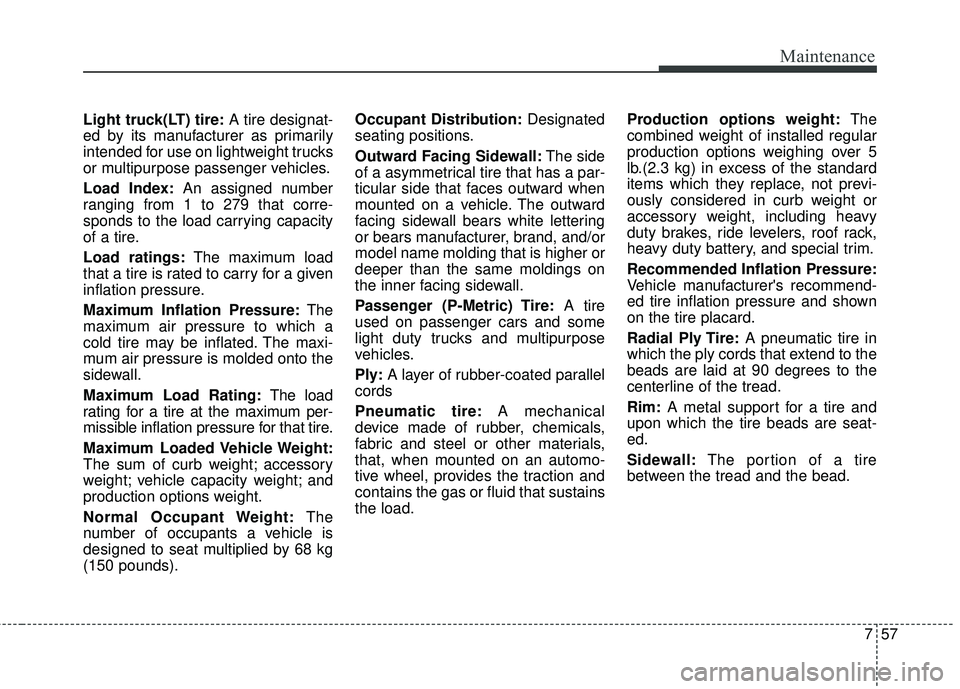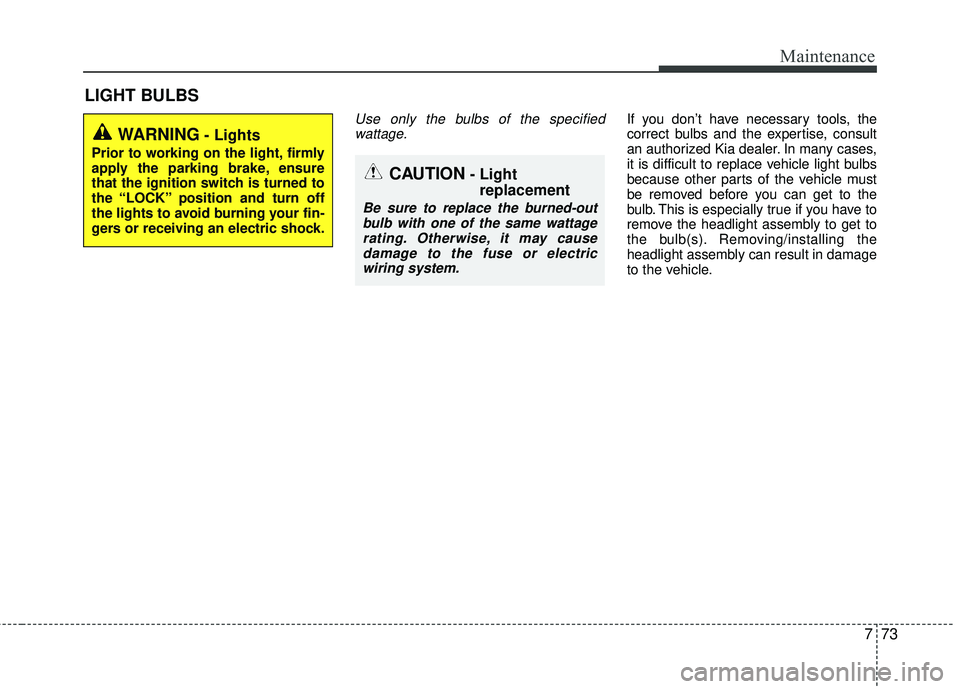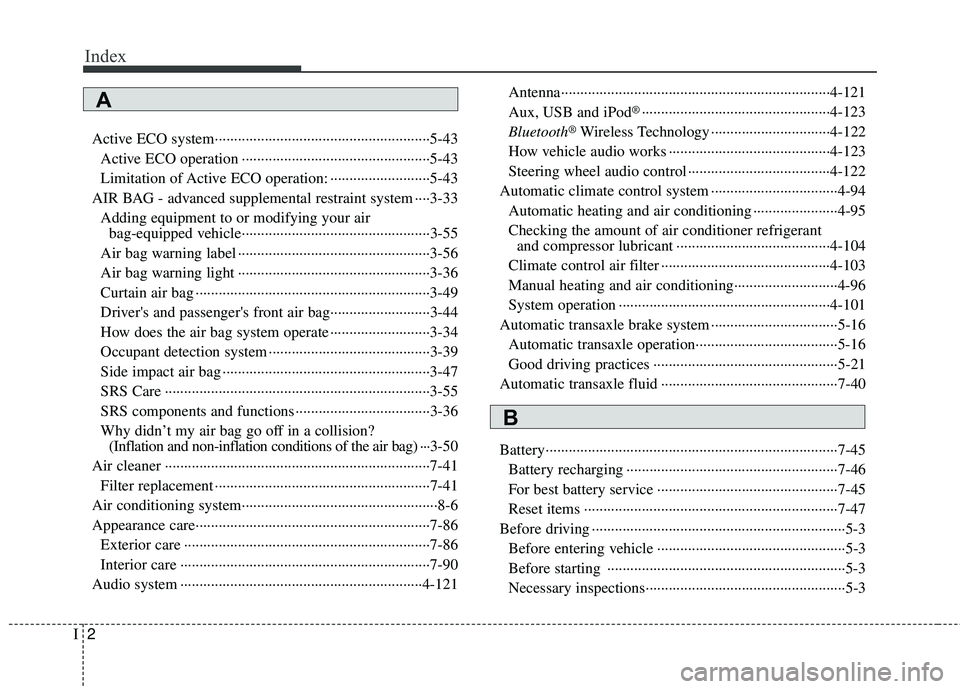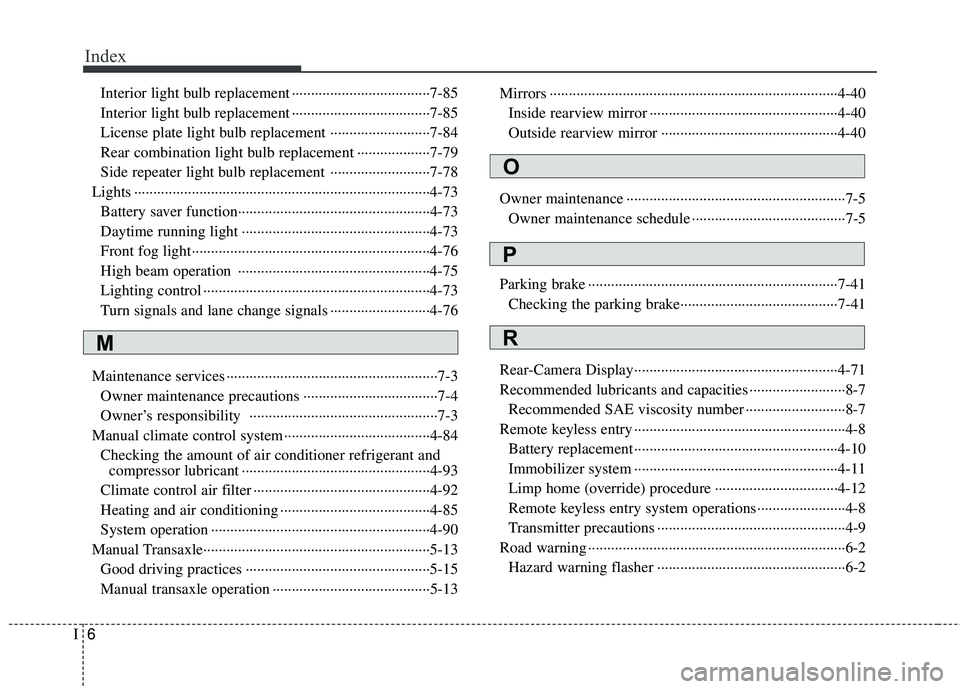2017 KIA RIO brake light
[x] Cancel search: brake lightPage 393 of 449

757
Maintenance
Light truck(LT) tire:A tire designat-
ed by its manufacturer as primarily
intended for use on lightweight trucks
or multipurpose passenger vehicles.
Load Index: An assigned number
ranging from 1 to 279 that corre-
sponds to the load carrying capacity
of a tire.
Load ratings: The maximum load
that a tire is rated to carry for a given
inflation pressure.
Maximum Inflation Pressure: The
maximum air pressure to which a
cold tire may be inflated. The maxi-
mum air pressure is molded onto the
sidewall.
Maximum Load Rating: The load
rating for a tire at the maximum per-
missible inflation pressure for that tire.
Maximum Loaded Vehicle Weight:
The sum of curb weight; accessory
weight; vehicle capacity weight; and
production options weight.
Normal Occupant Weight: The
number of occupants a vehicle is
designed to seat multiplied by 68 kg
(150 pounds). Occupant Distribution:
Designated
seating positions.
Outward Facing Sidewall: The side
of a asymmetrical tire that has a par-
ticular side that faces outward when
mounted on a vehicle. The outward
facing sidewall bears white lettering
or bears manufacturer, brand, and/or
model name molding that is higher or
deeper than the same moldings on
the inner facing sidewall.
Passenger (P-Metric) Tire: A tire
used on passenger cars and some
light duty trucks and multipurpose
vehicles.
Ply: A layer of rubber-coated parallel
cords
Pneumatic tire: A mechanical
device made of rubber, chemicals,
fabric and steel or other materials,
that, when mounted on an automo-
tive wheel, provides the traction and
contains the gas or fluid that sustains
the load. Production options weight:
The
combined weight of installed regular
production options weighing over 5
lb.(2.3 kg) in excess of the standard
items which they replace, not previ-
ously considered in curb weight or
accessory weight, including heavy
duty brakes, ride levelers, roof rack,
heavy duty battery, and special trim.
Recommended Inflation Pressure:
Vehicle manufacturer's recommend-
ed tire inflation pressure and shown
on the tire placard.
Radial Ply Tire: A pneumatic tire in
which the ply cords that extend to the
beads are laid at 90 degrees to the
centerline of the tread.
Rim: A metal support for a tire and
upon which the tire beads are seat-
ed.
Sidewall: The portion of a tire
between the tread and the bead.
Page 409 of 449

773
Maintenance
LIGHT BULBS
Use only the bulbs of the specifiedwattage.If you don’t have necessary tools, the
correct bulbs and the expertise, consult
an authorized Kia dealer. In many cases,
it is difficult to replace vehicle light bulbs
because other parts of the vehicle must
be removed before you can get to the
bulb. This is especially true if you have to
remove the headlight assembly to get to
the bulb(s). Removing/installing the
headlight assembly can result in damage
to the vehicle.
WARNING- Lights
Prior to working on the light, firmly
apply the parking brake, ensure
that the ignition switch is turned to
the “LOCK” position and turn off
the lights to avoid burning your fin-
gers or receiving an electric shock.
CAUTION- Light replacement
Be sure to replace the burned-out
bulb with one of the same wattagerating. Otherwise, it may causedamage to the fuse or electricwiring system.
Page 422 of 449

Maintenance
86
7
APPEARANCE CARE
Exterior care
Exterior general caution
It is very important to follow the label
directions when using any chemical
cleaner or polish. Read all warning and
caution statements that appear on the
label.
Finish maintenance
Washing
To help protect your vehicle’s finish from
rust and deterioration, wash it thoroughly
and frequently at least once a month with
lukewarm or cold water.
If you use your vehicle for off-road driv-
ing, you should wash it after each off-
road trip. Pay special attention to the
removal of any accumulation of salt, dirt,
mud, and other foreign materials. Make
sure the drain holes in the lower edges of
the doors and rocker panels are kept
clear and clean.
Insects, tar, tree sap, bird droppings,
industrial pollution and similar deposits
can damage your vehicle’s finish if not
removed immediately.
Even prompt washing with plain water
may not completely remove all these
deposits. A mild soap, safe for use on
painted surfaces, may be used.
After washing, rinse the vehicle thor-
oughly with lukewarm or cold water. Do
not allow soap to dry on the finish.
After washing the vehicle, test the brakes
while driving slowly to see if they have
been affected by water. If braking per-
formance is impaired, dry the brakes by
applying them lightly while maintaining a
slow forward speed.
High-pressure washing
When using high-pressure wash-
ers, make sure to maintain suffi-
cient distance from the vehicle.
Insufficient clearance or excessive
pressure can lead to component
damage or water penetration.
Do not spray the camera, sensors or its surrounding area directly with
a high pressure washer. Shock
applied from high pressure water
may cause the device to not oper-
ate normally.
Do not bring the nozzle tip close to boots (rubber or plastic covers) or
connectors as they may be dam-
aged if they come into contact with
high pressure water.
Page 442 of 449

Index
2I
Active ECO system··················\
··················\
··················\
··5-43Active ECO operation ··················\
··················\
·············5-43
Limitation of Active ECO operation: ··················\
········5-43
AIR BAG - advanced supplemental restraint system ····3-33 Adding equipment to or modifying your airbag-equipped vehicle··················\
··················\
·············3-55
Air bag warning label ··················\
··················\
··············3-56
Air bag warning light ··················\
··················\
··············3-36
Curtain air bag ··················\
··················\
··················\
·······3-49
Driver's and passenger's front air bag··········\
················3-44
How does the air bag system operate ··················\
········3-34
Occupant detection system ··················\
··················\
······3-39
Side impact air bag ··················\
··················\
··················\
3-47
SRS Care ··················\
··················\
··················\
···············3-55
SRS components and functions ··················\
·················3-36\
Why didn’t my air bag go off in a collision? (Inflation and non-inflation conditions of the air bag) ···3-50
Air cleaner ··················\
··················\
··················\
···············7-41 Filter replacement ··················\
··················\
··················\
··7-41
Air conditioning system··················\
··················\
···············8-6
Appearance care··················\
··················\
··················\
·······7-86 Exterior care ··················\
··················\
··················\
··········7-86
Interior care ··················\
··················\
··················\
···········7-90
Audio system ··················\
··················\
··················\
·········4-121 Antenna··················\
··················\
··················\
················4-121
Aux, USB and iPod
®··················\
··················\
·············4-123
Bluetooth
®Wireless Technology ··················\
·············4-122
How vehicle audio works ··················\
··················\
······4-123
Steering wheel audio control ··················\
··················\
·4-122
Automatic climate control system ··················\
···············4-94 Automatic heating and air conditioning ··················\
····4-95
Checking the amount of air conditioner refrigerantand compressor lubricant ··················\
··················\
····4-104
Climate control air filter ··················\
··················\
········4-103
Manual heating and air conditioning··················\
·········4-96
System operation ··················\
··················\
··················\
·4-101
Automatic transaxle brake system ··················\
···············5-16 Automatic transaxle operation··················\
··················\
·5-16
Good driving practices ··················\
··················\
············5-21
Automatic transaxle fluid ··················\
··················\
··········7-40
Battery··················\
··················\
··················\
··················\
····7-45 Battery recharging ··················\
··················\
··················\
·7-46
For best battery service ··················\
··················\
···········7-45
Reset items ··················\
··················\
··················\
············7-47
Before driving ··················\
··················\
··················\
············5-3 Before entering vehicle ··················\
··················\
·············5-3
Before starting ··················\
··················\
··················\
········5-3
Necessary inspections··················\
··················\
················5-3
A
B
Page 446 of 449

Index
6I
Interior light bulb replacement ··················\
··················\
7-85
Interior light bulb replacement ··················\
··················\
7-85
License plate light bulb replacement ··················\
········7-84
Rear combination light bulb replacement ··················\
·7-79
Side repeater light bulb replacement ··················\
········7-78
Lights ··················\
··················\
··················\
··················\
·····4-73 Battery saver function··················\
··················\
··············4-73
Daytime running light ··················\
··················\
·············4-73
Front fog light··················\
··················\
··················\
········4-76
High beam operation ··················\
··················\
··············4-75
Lighting control ··················\
··················\
··················\
·····4-73
Turn signals and lane change signals ··················\
········4-76
Maintenance services ··················\
··················\
··················\
·7-3 Owner maintenance precautions ··················\
·················7-4
Owner’s responsibility ··················\
··················\
·············7-3
Manual climate control system··················\
··················\
··4-84 Checking the amount of air conditioner refrigerant andcompressor lubricant ··················\
··················\
·············4-93
Climate control air filter ··················\
··················\
··········4-92
Heating and air conditioning ··················\
··················\
···4-85
System operation ··················\
··················\
··················\
···4-90
Manual Transaxle··················\
··················\
··················\
·····5-13 Good driving practices ··················\
··················\
············5-15
Manual transaxle operation ··················\
··················\
·····5-13 Mirrors ··················\
··················\
··················\
··················\
···4-40
Inside rearview mirror ··················\
··················\
·············4-40
Outside rearview mirror ··················\
··················\
··········4-40
Owner maintenance ··················\
··················\
··················\
···7-5 Owner maintenance schedule ··················\
··················\
····7-5
Parking brake ··················\
··················\
··················\
···········7-41 Checking the parking brake··················\
··················\
·····7-41
Rear-Camera Display··················\
··················\
·················4-71\
Recommended lubricants and capacities ··················\
·······8-7 Recommended SAE viscosity number ··················\
········8-7
Remote keyless entry ··················\
··················\
··················\
·4-8 Battery replacement ··················\
··················\
·················4-10\
Immobilizer system ··················\
··················\
·················4-11\
Limp home (override) procedure ··················\
··············4-12
Remote keyless entry system operations··················\
·····4-8
Transmitter precautions ··················\
··················\
·············4-9
Road warning ··················\
··················\
··················\
·············6-2 Hazard warning flasher ··················\
··················\
·············6-2
M
O
P
R